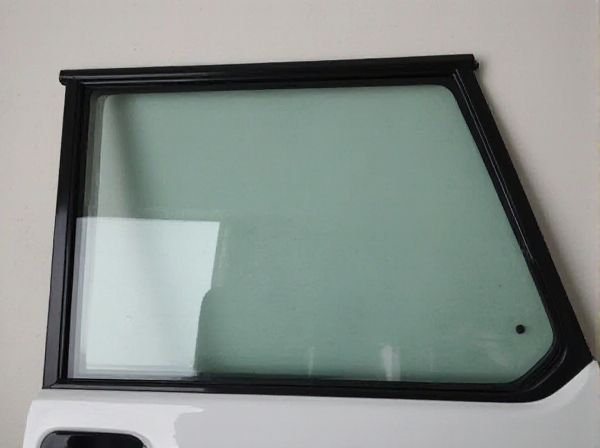
Photo illustration: Laminate Glass Door vs Tempered Glass Door
Laminate glass doors offer enhanced safety by holding shards together when broken, making them ideal for areas requiring impact resistance and security. Tempered glass doors provide superior strength and durability, shattering into small, less dangerous pieces upon impact, which is beneficial for environments prioritizing safety against breakage. Choosing the right door depends on your specific needs for safety, security, and performance in the intended space.
Table of Comparison
| Feature | Laminate Glass Door | Tempered Glass Door |
|---|---|---|
| Safety | Holds shards together on breakage, reduces injury risk | Shatters into small blunt pieces, minimizes cuts |
| Strength | Moderate impact resistance | 4-5 times stronger than regular glass |
| Sound Insulation | Superior noise reduction due to interlayer | Moderate noise insulation |
| UV Protection | Blocks up to 99% UV rays | Minimal UV protection |
| Cost | Higher cost due to multi-layer construction | Lower cost, simpler manufacturing |
| Use Case | Best for safety and sound comfort | Ideal for impact resistance and budget |
Introduction to Glass Doors
Glass doors enhance both aesthetic appeal and functionality in modern architecture, with laminate glass doors providing superior safety through a bonded interlayer that holds shards in place upon breakage. Tempered glass doors offer high strength and resistance to impact due to thermal or chemical treatment, making them ideal for areas requiring durability. Choosing between laminate and tempered glass depends on specific safety needs, design preferences, and application requirements in residential or commercial spaces.
What is Laminate Glass?
Laminate glass is a safety glass consisting of two or more layers of glass bonded together with an interlayer, typically made of polyvinyl butyral (PVB), which holds the glass fragments in place if broken. This construction provides enhanced security, sound insulation, and UV protection compared to traditional glass types. In contrast to tempered glass doors, which rely on heat treatment for strength, laminate glass doors prioritize shatter resistance and safety by preventing glass shards from dispersing.
What is Tempered Glass?
Tempered glass is a type of safety glass that is heat-treated to increase its strength compared to regular glass, making it highly resistant to impact and thermal stress. When broken, tempered glass shatters into small, blunt granules instead of sharp shards, reducing the risk of injury. This characteristic makes tempered glass ideal for doors, windows, and other applications requiring enhanced safety and durability.
Strength and Durability Comparison
Laminate glass doors consist of multiple layers of glass bonded with a tough interlayer, offering superior strength and resistance to impact, making them less prone to shattering compared to tempered glass doors. Tempered glass doors undergo a heat treatment process that increases their strength up to four times that of regular glass but tend to break into small, blunt pieces upon impact, enhancing safety but reducing structural integrity. For applications demanding both high durability and impact resistance, laminate glass doors provide enhanced protection, while tempered glass doors are preferred for their safety features and moderate strength.
Safety and Security Features
Laminate glass doors offer superior safety due to their construction, which includes a plastic interlayer that holds shattered glass fragments in place, reducing the risk of injury and enhancing break-in resistance. Tempered glass doors, while significantly stronger than regular glass and resistant to impact, shatter into small, blunt pieces upon breakage, providing safety but less security against forced entry compared to laminated options. For environments prioritizing both safety and enhanced security, laminate glass doors provide a distinct advantage by combining structural integrity with tamper resistance.
Sound Insulation Capabilities
Laminate glass doors provide superior sound insulation due to their multiple layers and interlayer that effectively dampen noise vibrations, reducing sound transmission compared to tempered glass doors. The interlayer in laminate glass acts as a sound barrier, significantly enhancing acoustic performance in environments where noise reduction is essential. Tempered glass doors, while strong and impact-resistant, offer less sound insulation as they consist of a single solid pane without the added damping properties found in laminate glass.
Cost and Affordability
Laminate glass doors generally cost more than tempered glass doors due to their multi-layered construction that provides enhanced security and sound insulation. Tempered glass doors are more affordable and offer high strength and safety by shattering into small, blunt pieces when broken. For budget-conscious projects requiring strength without premium features, tempered glass doors remain the cost-effective choice.
Design and Aesthetic Options
Laminate glass doors offer greater design flexibility with multiple layers that can incorporate decorative films, colors, and patterns, enhancing aesthetic appeal and customization possibilities. Tempered glass doors provide a sleek, modern look with a smooth, uniform surface and high clarity, ideal for minimalist and contemporary designs. Both options ensure durability and safety, but laminate glass excels in achieving unique visual effects while tempered glass emphasizes clean, transparent elegance.
Installation and Maintenance
Laminate glass doors require careful installation to ensure the interlayer remains intact and prevent delamination, often necessitating professionals experienced with their heavier weight and vulnerability to impact during fitting. Tempered glass doors offer easier installation due to their standardized strength and lighter weight, reducing the risk of damage during handling. Maintenance for laminate glass doors focuses on preserving the interlayer by avoiding abrasive cleaners, whereas tempered glass doors benefit from simple cleaning methods and exhibit higher resistance to scratches and impacts over time.
Choosing the Right Glass Door for Your Needs
Laminate glass doors offer enhanced safety with interlayers that hold shards together upon impact, making them ideal for high-traffic or security-sensitive areas. Tempered glass doors provide superior strength and resistance to thermal stress, suitable for environments requiring durability and heat resistance. Selecting the right glass door depends on balancing safety requirements, strength, and application-specific needs such as noise reduction or heat insulation.
 caratoz.com
caratoz.com